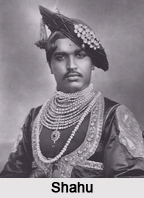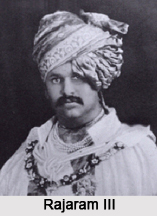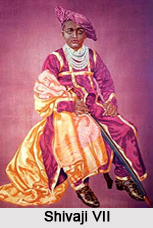 During British rule in India (which covers both the British East India Company rule and later the British Raj), the princely state of Kolhapur was ruled by different princes. Some had served the state as "Raja" and some served it as "Maharaja". Given below are the rulers of Kolhapur from the Bhonsle Dynasty.
During British rule in India (which covers both the British East India Company rule and later the British Raj), the princely state of Kolhapur was ruled by different princes. Some had served the state as "Raja" and some served it as "Maharaja". Given below are the rulers of Kolhapur from the Bhonsle Dynasty.
Rajas of Kolhapur
Shivaji III, the Raja of Kolhapur ruled from 22nd of September, 1762 to 24th of April, 1813. Sambhaji III, the Raja of Kolhapur ruled from 24th of April, 1813 to 2nd of July, 1821. Shivaji IV was the Raja of Kolhapur, who ruled from 2nd of July, 1821 to 3rd January, 1822. Shahaji"s reign as a monarch continued from 3rd of January, 1822 to 29th of November, 1838. Shivaji V was the Raja of Kolhapur, who ruled from 1838 to 1866. He was granted a personal salute of 19 guns with a hereditary salute of 17 guns. Rajaram II was the Raja of Kolhapur from 18th of August, 1866 to 30th November, 1870. During his tenure, the gun salute of the state was increased from 17 to 19 guns. Shivaji VI was the Raja of Kolhapur from 1871 to 1883. Shahu was the Raja of Kolhapur from 1884 to 1900
Rajaram II was the Raja of Kolhapur from 18th of August, 1866 to 30th November, 1870. During his tenure, the gun salute of the state was increased from 17 to 19 guns. Shivaji VI was the Raja of Kolhapur from 1871 to 1883. Shahu was the Raja of Kolhapur from 1884 to 1900
Maharajas of Kolhapur
Shahu was also the Maharaja of Kolhapur from 1900 to 1922. He had taken effort to make education and employment available to all. He had subsidized education, provided free education to all and set up several hostels in Kolhapur to educate the rural and low-caste indigent. The names of his educational institutions are Victoria Maratha Boarding School, Miss Clarke Boarding School and Deccan Rayat Sanstha. Suitable employment for educated students was also taken care of by the Maharaja. He is credited with the commencement of the Shahu Chhatrapati Weaving and Spinning Mill in 1906 to provide employment. He had also started the Rajaram College which was later named after him.
He is credited with the commencement of the Shahu Chhatrapati Weaving and Spinning Mill in 1906 to provide employment. He had also started the Rajaram College which was later named after him.
Rajaram III was the Maharaja of Kolhapur, who ruled from 1922 to 1940. He was a benevolent ruler which can be comprehended from the fact that he played a vital role in uplifting the dalits and depressed castes in his state, established the Kolhapur High Court and an updated water-supply system, started free primary education and higher-level female education and is also associated with modern housing developments.
Shivaji VII was the last Maharaja of Kolhapur, who ruled from 1941 to 1946. He was from the Satara branch of the Bhonsle Dynasty. As he was very young, the state was administered by regency during his lifetime.



















